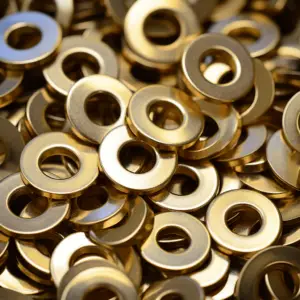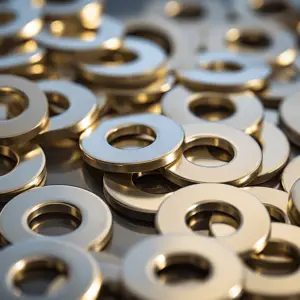Placement of Washers, A washer is most commonly a thin flat metal ring used with threaded fasteners such as bolts and screws that acts as a spacer, a seal, or a buffer to absorb the load created by the fastening process.
Sometimes the washers can take different shapes such as squares and may be made of different materials such as a particularly hard form of rubber or a polymer. The materials used with screws and bolts include plastic, metal, and wood.
These are generally referred to as the substrate.
Table of Contents
Where does the washer go on a screw?

By the above definition, a washer can therefore go on either side of the substrate or on both sides. In relation to the bolt, the washer can be placed directly beneath the head of the bolt, or it can go on the side of the nut, or on both sides.
The commonplace default is that if you are working with just one washer you should put it on the side of the nut but this may be misleading since in some cases it is better to put it just under the head of the bolt or the screw.
The best placement of washers is informed by a number of factors but first some clarification.
Difference between a screw and a bolt
Technically there is no universally accepted distinction between a screw and a bolt and many people use the terms interchangeably. There is however a distinction that generally seems to hold true across the board. Knowing this may help you decide which of the two best suits your project.
Both screws and bolts are threaded fasteners.
Screws are threaded fasteners that thread directly into the substrate and do not take a nut on the posterior end to tighten it.
They fasten into the substrate by ‘mating’ with the substrate creating threads in the substrate and securing themselves. They are therefore self-threading and self-tapping.
Bolts are also threaded fasteners that are either driven or placed into a hole in the substrate but take a threaded nut at the posterior end to fasten them. Bolts are therefore not self-tapping or self-threading and always come with nuts to hold them in place.
While both are used with washers, more commonly, you will find a screw without a washer to go with it, but bolts and nuts are almost always used with washers since they are often times stronger, thicker, and used where greater load will be exerted on a joint than a screw.
This informs the first reason for using a washer.
Factors influencing the use and placement of washers
As mentioned earlier, a washer is used as a buffer, a seal, or a spacer. Even without a washer, bolts and screws would still perform their job efficiently but the presence of a washer substantially improves the longevity of joinery and the general ergonomics of the substrate are improved. Washers offer;
- Load distribution
- Vibration absorption
- Sealant action
- Spacing
Load distribution
Threaded fasteners and fastening, in genera,l exerts pressure on the substrate creating a very targeted tension point when tightened. In metalwork, this may not be a problem especially when dealing with thick sheets of metal but in a substrate such as wood or other softer materials, fasteners may cause tears, chaffing, and even cracks.
Ironically, by fastening to secure a joint, you may create a new weak point at the same spot. Washers are vastly effective here and distribute the load from the fastener across a larger surface reducing the pressure on a single point.
Bed joints are a great example. Minus the washer, cracking the wood as you attempt to tighten the joint usually cracks the wood or cramps it creating a weak point that will soon give way. The washer prevents this.
Additionally, while two washers would be ideal, in this case, if you have one washer then it should go on the side of the head to stop the head from being fastened too deep into the wood and damaging it.
Vibration absorption
Placement of Washers a joint is part of a machine or appliance that vibrates often, then it stands to reason that it is expected to be jostled loose over time. This is not ideal and in many instances, it should be dangerous.
These joints must be fitted with washers to absorb vibration and prevent the bolts and the nuts from coming loose. These washers will likely be made of softer materials that absorb kinetic energy rather well such as rubber, certain plastic polymers, and proprietary resins designed to absorb such force.
Washing machines, cisterns, drilling machinery, and locomotives will have these kinds of washers in various joints. These washers should be placed on both sides of the fastener.
Sealant action

Washers at times are used to seal a joint and prevent fluid from flowing through the opening.
These kinds of washers are sometimes named gaskets and are commonly made of rubber and other polymers that are water-proof and have excellent sealant qualities such as the ability to sustain their volume within a large temperature range.
Boats, oil rigs, washing machines, swimming pools, medical equipment, and other appliances that handle liquids and gases have these types of washers to create air-tight and water-tight seals.
Spacing
Washers can be designed to distribute the size of a bolt evenly both on the anterior and the posterior portions of the substrate. This is particularly useful where bolts have been placed in tight spaces and it is difficult to grab hold of the tiny bolts and nuts used.
By using wide washers instead of flat ones, you may be able to provide better grip particularly when repairs and maintenance work is needed and the joint must be undone in order to achieve this.
Washers for spacing are also useful in large machines such as what would be found in factories and manufacturing plants.
Aside from the sheer need for large washers for load distribution, washers for spacing simply create more ergonomically friendly joints to work with since large joinery equipment may need more maintenance work and would therefore be easier to grip than proportionally tinier washers.
